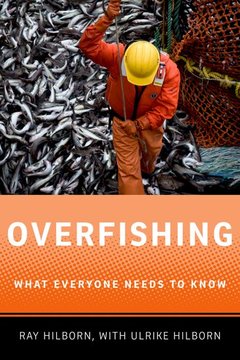Description
Overfishing
What Everyone Needs to Know®
What Everyone Needs To Know® Series
Authors: Hilborn Ray, Hilborn Ulrike
Language: English
Subjects for Overfishing:
Publication date: 06-2012
168 p. · 14.2x20.9 cm · Paperback
168 p. · 14.2x20.9 cm · Paperback
Description
/li>Contents
/li>Biography
/li>
Over the past twenty years considerable public attention has been focused on the decline of marine fisheries, the sustainability of world fish production, and the impacts of fishing on marine ecosystems. Many have voiced their concerns about marine conservation, as well as the sustainable and ethical consumption of fish. But are fisheries in danger of collapse? Will we soon need to find ways to replace this food system? Should we be worried that we could be fishing certain species to extinction? Can commercial fishing be carried out in a sustainable way? While overblown prognoses concerning the dire state of fisheries are plentiful, clear scientific explanations of the basic issues surrounding overfishing are less so - and there remains great confusion about the actual amount of overfishing and its ecological impact. Overfishing: What Everyone Needs to Know will provide a balanced explanation of the broad issues associated with overfishing. Guiding readers through the scientific, political, economic, and ethical issues associated with harvesting fish from the ocean, it will provide answers to questions about which fisheries are sustainably managed and which are not. Ray and Ulrike Hilborn address topics including historical overfishing, high seas fisheries, recreational fisheries, illegal fishing, climate and fisheries, trawling, economic and biological overfishing, and marine protected areas. In order to illustrate the effects of each of these issues, they will incorporate case studies of different species of fish. Overall, the authors present a hopeful view of the future of fisheries. Most of the world's fisheries are not overfished, and many once overfished stocks are now rebuilding. In fact, we can learn from the management failures and successes to ensure that fisheries are sustainable and contribute to national wealth and food security. Concise and clear, this book presents a compelling "big picture " of the state of oceans and the solutions to ending overfishing.
Preface. Chapter 1: Overfishing. What is overfishing?. What is a sustainable harvest?. Can fisheries be sustainably harvested?. Is overfishing a new problem?. Why does sustainable fishing reduce the number of fish in the ocean?. What is a collapsed fishery?. I have heard stories of the Canadian cod, what happened?. Why did the Canadian cod collapse?. Are all cod fisheries collapsed?. Chapter 2: Historical overfishing. Is overfishing a new problem?. Can whales be sustainably harvested?. How do we estimate the abundance of animals in the ocean?. Can scientists estimate the sustainable yield?. Is there any value in Japanese alt,"research whalingagt,"?. Is depleting one population and moving onto the next a common problem?. Chapter 3 : Recovery of Fisheries. Can fish stocks recover from overfishing?. How important is habitat to fish populations?. What about the enormous numbers seen by John Smith?. What is the difference between recruitment overfishing and growth overfishing?. Can recreational and commercial fisheries co-exist?. Chapter 4: Modern industrial fisheries management. What is an example of a well-managed fishery?. What is different about the pollock fishery that makes it such a good example of sustainable management?. Why does the allowable catch change so much from year to year?. What is a stock assessment?. What is an observer program?. Why are there not more observer programs in world fisheries?. What is a certified fishery?. Why do some NGOs believe the Eastern Bering Sea pollock fishery is not well managed?. Chapter 5: Economic Overfishing. Is overfishing only a biological problem?. What are individual fishermen's quotas, the IFQs?. What are the benefits of IFQs?. What are the negative impacts of IFQs?. What is economic overfishing?. How economically efficient are world fisheries in general?. How do we prevent economic overfishing?. Are there ways to prevent the tragedy of the commons without privatizing fisheries?. What are community development quotas?. How does sector allocation work?. What other mechanisms have been used to allocate fish?. Chapter 6: Climate and fisheries. How does climate affect fish populations?. Are many fisheries affected by climate?. How can we tell if a fishery is declining because of climate or fishing pressure?. What are going to be the impacts on fisheries from a warming ocean?. What will be the impacts of ocean acidification?. Chapter 7: Mixed fisheries. Do fisheries catch one species or more?. What determines how hard a fish species can be harvested?. How do we balance harvesting high- and low-productivity species in mixed fisheries?. What is alt,"underfishing"?. Is it better to give up potential yield of productive species to keep unproductive species at high abundance?. How can we manage fisheries to reduce the mixed nature of the fishery?. Chapter 8: High Seas Fisheries. What is the status of bluefin tuna that were proposed for CITES listing?. What is the status of tuna around the world?. Are there examples of international fisheries management organizations that have been successful?. Why are some tuna stocks under-exploited and others overexploited?. Is there hope for managing these high-seas fisheries?. Chapter 9: Deepwater fish
Ray Hilborn is Professor in the School of Aquatic and Fishery Sciences at the University of Washington. Ulrike Hilborn is a writer and has worked with her husband, Ray, for 37 years.
© 2024 LAVOISIER S.A.S.
These books may interest you

Atlantic CodA Bio-Ecology 185.98 €



